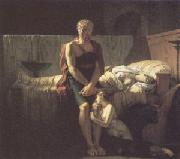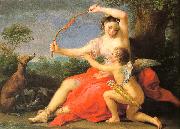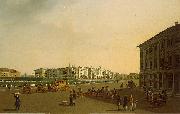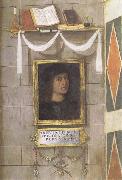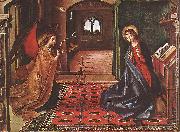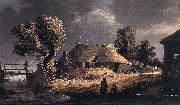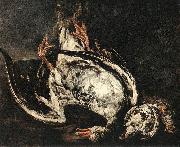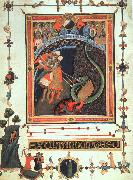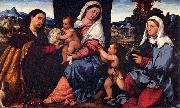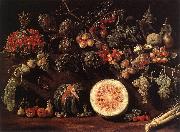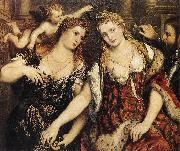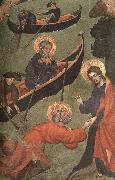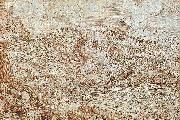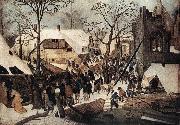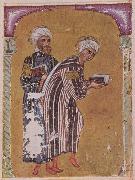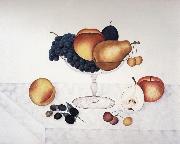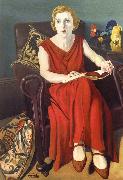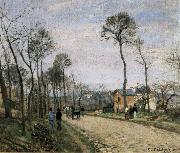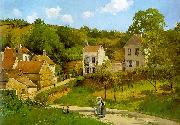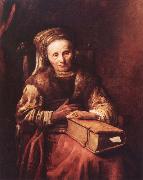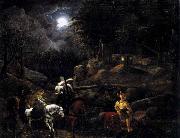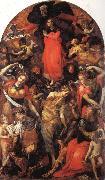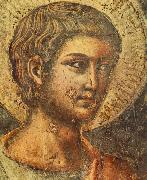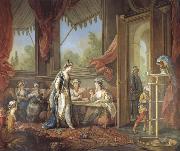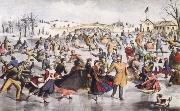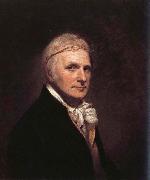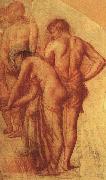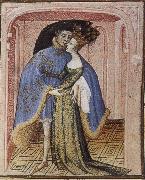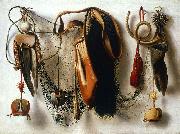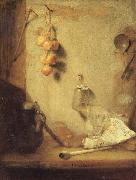|
|
 |
Baldassarre Peruzzi
|
|
(7 March 1481 - 6 January 1536) was an Italian architect and painter, born in a small town near Siena and died in Rome. He worked for many years, beginning in 1520, under Bramante, Raphael, and later Sangallo during the erection of the new St. Peter's. He returned to his native Siena after the Sack of Rome (1527) where he was employed as architect to the Republic. For the Sienese he built new fortifications for the city and designed (though did not build) a remarkable dam on the Bruna River near Giuncarico. He seems to have moved back to Rome by 1535.
He was a painter of frescoes in the Cappella San Giovanni in the Duomo of Siena.
His son Giovanni Sallustio was also an architect.
|
|
|
|
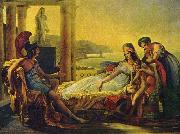 |
Baron Pierre-Narcisse Guerin
|
|
(13 May 1774 - 6 July 1833) was a French painter.
Guerin was born in Paris.
A pupil of Jean-Baptiste Regnault, he carried off one of the three grands prix offered in 1796, in consequence of the competition not having taken place since 1793. In 1799, his painting Marcus Sextus (Louvre) was exhibited at the Salon and excited wild enthusiasm. Part of this was due to the subject - a victim of Sulla's proscription returning to Rome to find his wife dead and his house in mourning - in which an allusion was found to the turmoil of the French Revolution.
Guerin on this occasion was publicly crowned by the president of the Institute, and went to Rome to study under Joseph-Benoît Suvee. In 1800, unable to remain in Rome on account of his health, he went to Naples, where he painted the Grave of Amyntas. In 1802 Guerin produced Phaedra and Hippolytus (Louvre); in 1810, after his return to Paris, he again achieved a great success with Andromache and Pyrrhus (Louvre); and in the same year also exhibited Cephalus and Aurora (Louvre) and Bonaparte and the Rebels of Cairo (Versailles). These paintings suited the popular taste of the First Empire, being highly melodramatic and pompously dignified.
The Restoration brought to Guerin fresh honours; he had received from the first consul in 1803 the cross of the Legion of Honour, and in 1815 Louis XVIII named to the Academie des Beaux-Arts. His style changed to accord with popular taste. In Aeneas Relating to Dido the Disasters of Troy (Louvre), Guerin adopted a more sensuous, picturesque style.
Guerin was commissioned to paint for the Madeleine a scene from the history of St Louis, but his health prevented him from accomplishing what he had begun, and in 1822 he accepted the post of director of the French Academy in Rome, which in 1816 he had refused. On returning to Paris in 1828, Guerin, who had previously been made chevalier of the order of St. Michel, was ennobled. He now attempted to complete Pyrrhus and Priam, a work which he had begun at Rome, but in vain; his health had finally broken down, and in the hope of improvement he returned to Italy with Horace Vernet. Shortly after his arrival at Rome Baron Guerin died, on the 6th of July 1833, and was buried in the church of La Trinite de Monti by the side of Claude Lorrain.
|
|
 |
Bartolome Perez
|
|
(1634-1693) was a Spanish painter of the Baroque period.
Born in Madrid, he became the son-in-law and pupil of the painter Juan de Arellano. Known as a painter of flowers and still life, known as bodegones. He also painted scenography for performances at the theater of Buen Retiro, for which he was named painter of the King without salary in January of 1689. He died after falling from a scaffold used to paint the ceiling of the palace of Monteleon, and was buried in the church of San Ildefonso.
|
|
 |
Bartolomeo Passerotti
|
|
(1529-1592) was an Italian painter of the mannerist period, who worked mainly in his native Bologna.
He traveled to Rome in the mid-16th century, where he worked under Girolamo Vignola and Taddeo Zuccari. Upon returning to Bologna, he accumulated a large studio, and influenced many Bolognese who would later play a role in the rise of the Baroque. Annibale Carracci (whose brother Agostino studied with Passarotti) was influenced by Passarotti's genre scenes in a select set of paintings (such as The Beaneater and The Butcher's Shop, the latter being originally attributed to Passarotti). Lucio Massari and Francesco Brizzi were among his pupils. Four of Passarotti's sons, including Ventura, Aurelio, Tiburzio, and Passarotto were painters.
|
|
|
|
|
|
|
|
|
|
|
|
|
|
|
|
 |
Bonaventura Peeters
|
|
(Antwerp, 23 July 1614 - Hoboken (Antwerp), 25 July 1652) was a Flemish Baroque painter who specialized in seascapes and shipwrecks, known as Zeekens (small seascapes).
Peeters, brother of the seascape painters Jan Peeters I, Gillis Peeters, and Catharina Peeters, learned to paint from his father, who became a master in Antwerp's guild of St. Luke in 1607 - 1608, and his earlier works are related to the tonal phase of Dutch landscape painting. Later paintings, however, reflect the stronger colors of Italianate classicism. This shift follows the general changes in artistic style at the time. Like his brother Jan, dramatic shipwrecks with dark billowy clouds, form a significant part of his oeuvre, as do serene ports and "portraits" of ships.Also, while many of Peeters's paintings reflect actual locations, and he may have even travelled along the coast of Scandinavia, his many views of far-away Mediterranean and Middle Eastern ports reflect a growing taste for the exotic and are probably inspired from fantasy and from prints. This tradition developed simultaneously in Flemish painting and in Dutch Golden Age painting, with many artists, including Peeters, working in both Antwerp and in the Dutch Republic. |
|
|
|
|
|
|
|
|
|
|
|
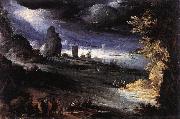 |
BRIL, Paul
|
|
Flemish Baroque Era Painter, ca.1554-1626 |
|
|
|
|
|
|
|
|
|
|
|
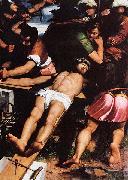 |
Callisto Piazza
|
|
(1500-1561) was an Italian painter.
Callisto, a member of the Piazza family of painters, was born in Lodi, Lombardy.
In 1523 he was working in Brescia. His first dated and signed work is from the following year, and shows a typical Brescian style. This style was then emerging, and included artists such as Romanino and Moretto. Piazza shows influences from contemporaries such as Dosso Dossi and Ludovico Mazzolino of the Ferrarese school, as well as Giovanni Agostino da Lodi.
In 1526-1529 Piazza worked in Val Camonica, at Erbanno, Borno, Breno, Esine and Cividate Camuno. In 1529 he returned to his native Lodi where he formed a workshop with his brothers Cesare and Scipione (died 1552). In 1538, while in Crema, he married the noblewoman Francesca Confalonieri. Later Callisto moved to Milan, where he received numerous commissions, such as the decoration of the San Girolamo chapel in Santa Maria Presso San Celso (1542); the decoration of the refectory of the convent of Sant'Ambrogio (1545); the frescoes for the Saletta Negra in the Castello Sforzesco; and the decoration of the Simonetta chapel in San Maurizio al Monastero Maggiore (1555), largely executed with the assistance of his son Fulvio. He also worked in Lodi at the Incoronata (1454), Novara, at the Abbey of Chiaravalle and other areas of Lombardy.
|
|
|
|
|
|
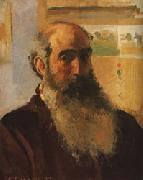 |
Camille Pissarro
|
|
Caribbean-born French Pointillist/Impressionist Painter, ca.1830-1903 |
|
 |
Camillo Procaccini
|
|
(1551 - August 21, 1629) was an Italian painter. He has been posthumously referred to as the Vasari of Lombardy, for his prolific Mannerist fresco decoration.
Born in Bologna, he was the son of the painter Ercole Procaccini the Elder, and older brother to Giulio Cesare and Carlo Antonio, both painters.
In 1587 he distinguished in the fresco decoration of the Basilica della Ghiara in Reggio Emilia. In the late 1580s he moved to Milan, where count Camillo Visconti Borromeo commissioned him the decoration of his villa in Lainate. The organ shutters for the Cathedral of Milan were painted after 1590 by Camillo, Giuseppe Meda (died 1599), and Ambrogio Figino. His other works of note include the frescoes of the nave and the apse of the Cathedral of Piacenza in collaboration with Ludovico Carracci (1605 - 1609), and the vault and choir in Santi Paolo e Barnaba of Milan. Also famous is a Nativity in the Sacro Monte d'Orta. Among his pupils is Carlo Biffi.
Among his many other works are a Martyrdom of St. Agnes painted in fresco in the sacristy of Milan cathedral; a Madonna and Child painted for the church of Santa Maria del Carmine; an 'Adoration of the Shepherds found in the Brera; and the ceiling of the church of Padri Zoccolanti, representing the Assumption of the Virgin. eall in the same city. He also painted a Last Judgment for the church of San Prospero at Reggio; He painted a St. Roch administering the Sacrament to the Plague-stricken.
|
|
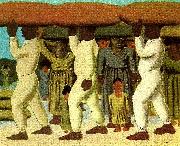 |
Candido Portinari
|
|
Candido Portinari (Brodowski, December 29, 1903 - Rio de Janeiro, February 6, 1962) was one of the most important Brazilian painters and also a prominent and influential practitioner of the neo-realism style in painting.
Born of Italian immigrants in a coffee plantation near Brodowski, in São Paulo, Portinari studied at the Escola Nacional de Belas Artes (ENBA) in Rio de Janeiro. In 1928 he won a gold medal at the ENBA and a trip to Paris where he stayed until 1930, when he returned to Brazil.
He joined the Brazilian Communist Party and stood for senator in 1947 but had to flee Brazil for Uruguay due to the persecution of Communists. He returned to Brazil in 1951 but suffered ill health during the last decade of his life and died in 1962 due to lead poisoning from his paints. |
|
|
|
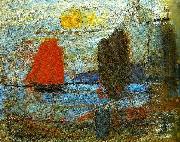 |
carl kylberg
|
|
Carl Oscar Kylberg, född 23 september 1878 på Vasängen i Fridene församling, död 6 januari 1952 i Stockholm, svensk konstnär och representant för Göteborgskoloristerna.
Carl Kylberg var son till kontorschef Gustaf Kylberg och friherrinnan Eleonora von Essen och storebror till konstnären Erik Kylberg. Hans fastrar och farbror var konstnärerna Regina Kylberg-Bobeck, Marina Kylberg och Hjalmar Kylberg. Farfadern Lars Wilhelm Kylberg var konstnär vid sidan av lantbruket på familjegodset Såtenäs i Västergötland.
Kylberg studerade först vid tekniska skolan i Stockholm och i Berlin för att bli arkitekt men övergick till måleri omkring 1900. Han studerade under en tid vid Valand i Göteborg som elev till Carl Wilhelmson. Hans verk kännetecknas ofta av ett glödande oljemåleri med starka färger och han avbildade ofta landskap och figurkompositioner på ett avskalat man??r. Under senare delen av sitt konstnärskap skapade han en mängd religiösa motiv.
Kring 1930-talet fick han sitt genombrott och han kom att ställa ut, förutom i Sverige även i Köpenhamn, Paris, London, Budapest och i USA men hans måleri var för många provocerande och 1938 gick regeringen in och stoppade ett köp av målningen Uppbrottet för Nationalmuseum i Stockholm.
En av hans mest välkända målningar är Hemkomsten från 1938 som hänger på Göteborgs konstmuseum och som föreställer ett skepp i silhuett mot en nästan brinnande gul himmel och ett rödfärgat hav. Denna målning förevigades också 1978 på ett svenskt frimärke av valören 90 öre.
Sedan 1980-talet har många av hans tavlor sålts för rekordpriser vid olika internationella konstauktioner.
|
|
|
|
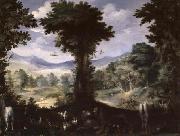 |
Carlo Antonio Procaccini
|
|
(born 1555) was an Italian painter of the late-Renaissance period.
He was the third son of Ercole, the brother of Camillo and Giulio Cesare the elder, and father of Ercole Procaccini the Younger (1605 - 1675). He was born at Bologna and initially trained by his father, though he excelled in painting landscapes and still-lifes with flowers and fruit, mainly in Milan.
|
|
|
|
|
|
|
|
|
|
|
|
|
|
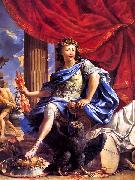 |
Charles Poerson
|
|
French Painter, 1609-1667
He studied under his own father Charles Poerson (himself a former pupil of Simon Vouet) and under Noël Coypel. His notable works include "Dispute Between Neptune and Minerva" at Chateau de Fontainebleau, "Union of the Academie royale de Paris and the Academy of Saint Luke in Rome" at Versailles and participation in the decoration of the Hotel des Invalides. He was buried in San Luigi dei Francesi, Rome, in a tomb attributed to the sculptor Pierre de L'Estache, who later became another director of the Academy. |
|
|
|
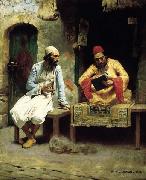 |
Charles Sprague Pearce
|
|
For other people named Charles Pearce, see Charles Pearce (disambiguation).
Charles Sprague Pearce (October 13, 1851 - May 18, 1914) was an American artist.
|
|
|
|
|
|
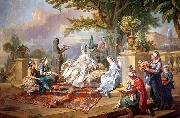 |
Charles-Amedee-Philippe van Loo
|
|
(25 August 1719 -15 November 1795) was a French painter of allegorical scenes and portraits.
He studied under his father, the painter Jean-Baptiste van Loo, at Turin and Rome, where in 1738 he won the Prix de Rome, then at Aix-en-Provence, before returning to Paris in 1745. He was invited to join the Academie Royale de Peinture et de Sculpture in 1747, and that year he married his cousin Marie-Marguerite Lebrun, daughter of the painter Michel Lebrun (died 1753).
Among his brothers were the painters François van Loo (1708-1732) and Louis-Michel van Loo (1707-1771).
|
|
|
|
|
|
|
|
|
|
|








